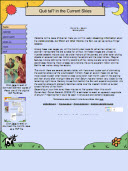| | Volume 18 -- Issue 8
August 2012
Welcome to this issue of Qué tal. Here you will find useful observing information
about the visible planets, our Moon and other
moons, the Sun, as well as various 'things' celestial.
Among
these web pages you will find monthly star maps for either the northern
or southern hemisphere that are suitable for printout. Animated
images are utilized to illustrate celestial motions such as orbital
motions of the planets, and other solar orbiting objects, or apparent
and real motions along the ecliptic and the local horizon. Regular
features include plotting the monthly positions of the visible planets
using heliocentric coordinates; following moon phases; conjunctions; the sun's
apparent motion and the Earth's real motion along the ecliptic.
This web site, for some reason, does not format properly when viewed with Internet Explorer browser.
Qué tal is also available in the Adobe PDF version and is readable with an e-reader that can load
PDF files.
Click on the image to the right to view or download the current issue.
For additional useful Earth and Space news, information, and graphics follow my WordPress Blog at Bob's Spaces, or as Tweets, or as an RSS feed.
Click on an image to the right.
Click here to watch some of my video work posted on You Tube.
|




|
This month, despite the weather, is one of those months where having a pair of binoculars or a low-power wide-field eyepiece for your telescope
will really get some use. With a pair of 7x35 binoculars in the morning skies around sunrise you can see Jupiter and the stars of the open star cluster the Hyades,
as well as Venus near a more distant open star cluster,M-35. At around sunset look west for Mars, Saturn, and the star Spica to all be within the same field
of view for much of the month.
The annual Perseid Meteor Shower peaks on the morning of the 12th but you can 'catch' a falling star in the days before and after the
peak date.
View asteroid Vesta for several mornings as it passes by the star Aldebaran.
Qué tal Theater this month features some videos about the planet Mars.
Tell someone about Qué tal?
in the Current Skies. Click here.
|